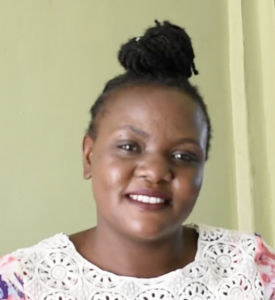Every day, the 210 individuals that make up the population of Eshisari face an overwhelming challenge - the shortage of clean water. With no access to treated water, they have no choice but to consume untreated water, which unfortunately results in waterborne diseases, including diarrhea, stomach pain, and typhoid fever.
"The water is not clean for drinking. Most of the time [when] taking this water without treatment, my whole household has suffered stomachache issues and typhoid. This has cost me to spend so much money [at] the hospital," said 40-year-old farmer Caroline Matangwe, shown below collecting water.

"I wouldn't drink from this water source. The source is open to contamination. Animals like dogs and cows drink directly from the source," said our field officer Adelaide Nasimiyu.
Obtaining water from the open spring is not only inconvenient but also unhygienic. Accessing the spring is difficult, and community members often have to stand in stagnant water that reaches their ankles to collect the meager flow of water that comes through makeshift metal roofing. This process is time-consuming and exhausting, taking up a lot of people's energy.

"Fetching water from this water point is not easy. Sometimes you find the piece of the iron sheet that is used to ease the process of drawing water missing. Fetching water becomes difficult," continued Caroline.
The challenges posed by the spring and the risks associated with consuming contaminated water are impeding the ability of individuals to carry out their everyday responsibilities. The absence of clean water is having a detrimental impact on the well-being of both children and adults residing in Eshisari.

"I usually fetch water in the morning before going to school. Sometimes you find a queue at the water point. This makes me late for school. Every day I get punished for coming to school late. The teachers wouldn't listen to any excuse. This has made [my] grades drop greatly because I miss remedial lessons and lack time to study," shared 11-year-old Revelious M. (shown above).

The spring's protection will enable Caroline, Revelious, and the others in their community to focus on regaining their health and time instead of wasting the resources they need to improve their lives. With access to clean water, children of the Eshiari community can make school their main priority, giving them the tools they need to build a better future for themselves and their community.
The Proposed Solution, Determined Together...
At The Water Project, everyone has a part in conversations and solutions. We operate in transparency, believing it benefits everyone. We expect reliability from one another as well as our water solutions. Everyone involved makes this possible through hard work and dedication.
In a joint discovery process, community members determine their most advantageous water solution alongside our technical experts. Read more specifics about this solution on the What We're Building tab of this project page. Then, community members lend their support by collecting needed construction materials (sometimes for months ahead of time!), providing labor alongside our artisans, sheltering and feeding the builders, and supplying additional resources.
Water Access for Everyone
This water project is one piece in a large puzzle. In Kenya, Sierra Leone, and Uganda, we're working toward complete coverage of reliable, maintained water sources that guarantee public access now and in the future within a 30-minute round trip for each community, household, school, and health center. One day, we hope to report that this has been achieved!
Training on Health, Hygiene & More
With the community's input, we've identified topics where training will increase positive health outcomes at personal, household, and community levels. We'll coordinate with them to find the best training date. Some examples of what we train communities on are:
- Improved hygiene, health, and sanitation habits
- Safe water handling, storage & treatment
- Disease prevention and proper handwashing
- Income-generation
- Community leadership, governance, & election of a water committee
- Operation and maintenance of the water point
Chlorine Dispensers
Installing chlorine dispensers is an important piece of our spring protection projects. Protecting a spring provides community members with an improved water source, but it doesn’t prevent contamination once the water is collected and stored. For example, if the water is clean and the container is dirty, the water will become contaminated.
We ensure that each chlorine dispenser is filled with diluted chlorine on a consistent schedule so that people can add pre-measured drops to each container of water they collect. That way, community members can feel even more confident in the quality of their water.



 Rehabilitation Project
Rehabilitation Project
































